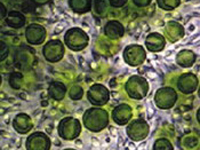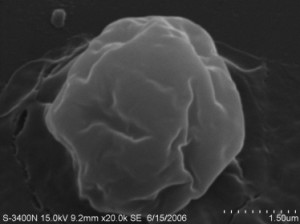By Bob McCauley, ND
From Achieving Great Health: The Seven Components of Natural Health
The fiber in Chlorella is famous for removing heavy metals and other synthetic toxins from the body. One of the absorbing substances in Chlorella fiber is sporopollenin, a naturally occurring carotene-like polymer that is extremely resistant to degradation. Chlorella’s cell wall is comprised of 3 layers. The middle layer contains the thickest cellulose microfibrils. The outer layer is extremely resistant to tearing or breakage. The characteristics of this fiber are unique to Chlorella and why it is so important that we consistently have Chlorella in our diet because it is not found in any other food source. Even dead Chlorella has the ability to soak up toxins after it has bonded with them.[i]
 One of the central qualities of all algae is the ability to absorb toxins, which is why only algae that are cultivated in a controlled environment should be consumed. Algae harvested from the wild contains the toxins it has absorbed from its natural source, whether a lake, pond or swamp. Algae harvested from a populated lake that recreational boats regularly use will contain the toxins produced by those boats.
One of the central qualities of all algae is the ability to absorb toxins, which is why only algae that are cultivated in a controlled environment should be consumed. Algae harvested from the wild contains the toxins it has absorbed from its natural source, whether a lake, pond or swamp. Algae harvested from a populated lake that recreational boats regularly use will contain the toxins produced by those boats.
The Japanese were the first to discover the incredible detoxifying properties of Chlorella to remove poisonous substances from the body such as radiation. After atomic weapons were dropped on Hiroshima and Nagasaki, Chlorella was used to remove radiation from the bodies of those who had become contaminated. Chlorella soaks up radiation like a sponge. Ionized Water is also good for the removal of radiation from the body, as is the far-infrared sauna. Due to sudden and uncontrolled industrialization after World War II, the Japanese population also experienced wide-spread mercury poisoning, which leads to Minamata disease. Chlorella’s cell wall fiber binds with toxic substances such as mercury and effectively removes them from the body through the bowels.
 It also readily removes lead, uranium[ii], dioxins and cadmium from the body. “It appears the detoxification effect is due both to the chlorophyll content of Chlorella and to the composition of its cell walls.”[iii] In one study, toxic substances such as mercury, copper, cadmium and PCB were added to an active culture of brewer yeast, which immediately killed it; however, when Chlorella was added to the yeast it survived. Another study gave the hydrocarbon chlordecone[iv] to various animals that were then fed Chlorella. The Chlorella stopped the circulation of the chlordecone and removed it from the animals. Chlorella fed to rats that had been exposed to insecticides demonstrated that those toxins were removed from them twice as quickly than from rats not given Chlorella. Dr. S. Pore of the School of Medicine, West Virginia University, did a similar study which demonstrated that the half-life of toxins such as these was decreased from 40 to 19 days with the use of Chlorella.
It also readily removes lead, uranium[ii], dioxins and cadmium from the body. “It appears the detoxification effect is due both to the chlorophyll content of Chlorella and to the composition of its cell walls.”[iii] In one study, toxic substances such as mercury, copper, cadmium and PCB were added to an active culture of brewer yeast, which immediately killed it; however, when Chlorella was added to the yeast it survived. Another study gave the hydrocarbon chlordecone[iv] to various animals that were then fed Chlorella. The Chlorella stopped the circulation of the chlordecone and removed it from the animals. Chlorella fed to rats that had been exposed to insecticides demonstrated that those toxins were removed from them twice as quickly than from rats not given Chlorella. Dr. S. Pore of the School of Medicine, West Virginia University, did a similar study which demonstrated that the half-life of toxins such as these was decreased from 40 to 19 days with the use of Chlorella.
In the 1950’s, the U.S. army tested the effects of Chlorella on guinea pigs that had been exposed to X-rays and found that a diet rich in chlorophyll demonstrated a marked increase in resistance to the lethal rays. A Japanese study of cadmium poisoning showed that feeding the test animals as little as eight grams of Chlorella each day increased the removal of cadmium three times in the stool and seven times in the urine.[v]
”The cell walls of Chlorella have three layers, of which the thicker middle layer contains cellulose microfibrils, and the outer layer a polymerized carotenoid material. It is this cellular material which first binds the toxic material and then removes it from the body.”[vi]
A 1986 Scottish study demonstrated that Chlorella removed cadmium from tissue using two processes, first binding it with the outer cell wall, which is composed of protein and polysaccharides, then slowly absorbing it through intracellular uptake.[vii]
“We can do experiments to show that Chlorella absorbs heavy metals from water. So if you use Chlorella . . . it will remove heavy metals such as lead, mercury and cadmium from the body”.[viii]
 Studies with Chlorella have been done on people with PCB (polychlorobiphenyl, a fire retardant) exposure. After taking only 4 – 6 grams of Chlorella each day for one year, all showed marked improvement as well as reduced PCB levels in their bodies.[ix] High PCB levels have been found to be 10 – 100 times higher in women’s breast milk in the United States compared to European women.[x] Chlorella has the potential to become a keystone in reducing the worldwide epidemic of toxicity.
Studies with Chlorella have been done on people with PCB (polychlorobiphenyl, a fire retardant) exposure. After taking only 4 – 6 grams of Chlorella each day for one year, all showed marked improvement as well as reduced PCB levels in their bodies.[ix] High PCB levels have been found to be 10 – 100 times higher in women’s breast milk in the United States compared to European women.[x] Chlorella has the potential to become a keystone in reducing the worldwide epidemic of toxicity.
“Chlorella’s ability to detoxify the body is very significant because of the large amount of chemicals we are exposed to in today’s modern world. This ability to detoxify chemicals is also one of the important differences between Chlorella and other “green” products.”[xi]
Thoroughly researching Chlorella will reveal that it has extremely low levels of lead and mercury in it. Only the most forthcoming Chlorella producers will admit this and list it in its product content because all Chlorella naturally contains it. Dr. T. Nagano at Shizuoka College of Pharmacy in Japan did a study in which Chlorella laced with cadmium was fed to rats. Their growth rate was not affected and blood levels did not show an increase in cadmium levels, which demonstrated that the cadmium remained bound to the Chlorella and was not released from it or absorbed into the rats’ tissue.
[i] Bioconcentration of four pure BCB Isomers by Chlorellapyrenoidosa, Urey, J.C., et al. Bull Envir. Contam. Toxicol. 16, 1976, S. 81-85.
[ii] Dr. Horikoshi did a study in 1979 which showed a significant amount of uranium was removed from people with exposure to this toxin.
[iii] Chlorella– The sun-powered supernutrient and its beneficial properties, by William H. Lee, R. Ph., Ph.D. and Michael Rosenbaum, M.D.
[iv] An insecticide, also known as Kepone, an established carcinogen.
[v] Chlorella– The sun-powered supernutrient and its beneficial properties.
[vi] Chlorella– Natural Medicinal Algae, by Dr David Steenblock , B.S., M.Sc.
[vii] Chlorella– The sun-powered supernutrient and its beneficial properties.
[viii] Dr. Liang-Pin Lin of National Taiwan University.
[ix] Dr. Ueda of the Kitakyushu City Institute for Environmental Pollution Research conducted the study.
[x] Environmental Working Group, 2003. Study done with 20 women from 14 states between November 2002 and June 2003.


Pingback: Chem Trails, Heavy Metals, Chlorella and Spirulina | Bob McCauley's Blog